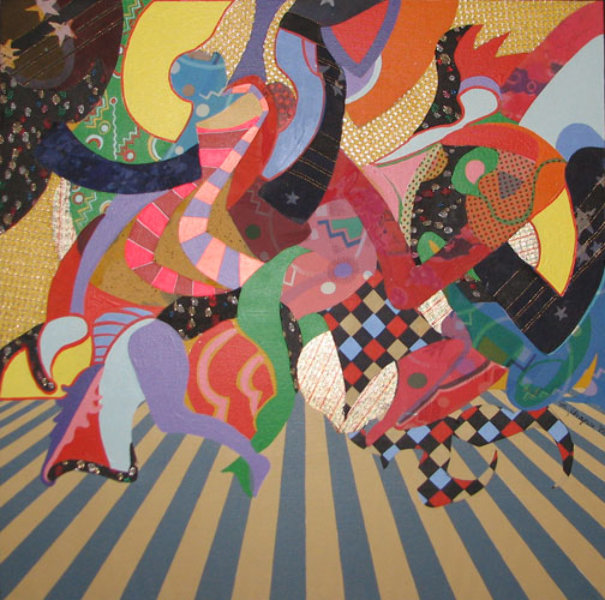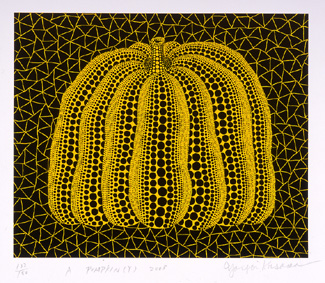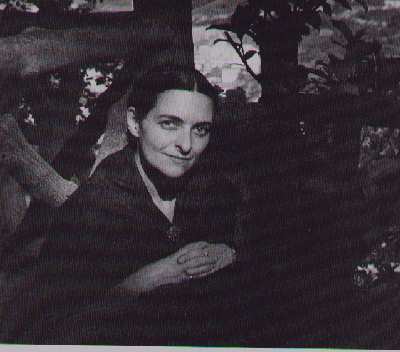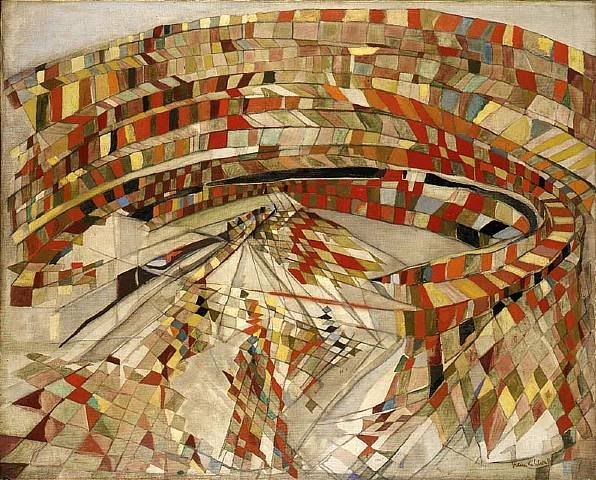Yayoi Kusama (草間 彌生 or 草間 弥生, Kusama Yayoi?, born March 22, 1929 in Matsumoto, Nagano Prefecture) is a Japanese artist whose paintings, collages, soft sculptures, performance art and environmental installations all share an obsession with repetition, pattern, and accumulation. (She has described herself as an "obsessive artist".)
Kusama's work is based in Conceptual art and shows some attributes of feminism, minimalism, surrealism, Art Brut, pop art, and abstract expressionism, and is infused with autobiographical, psychological, and sexual content. Kusama is also a published novelist and poet, and has created notable work in film and fashion design. wikipedia
Started to paint using polka dots and nets as motifs at around age ten ,and created fantastic paintings in watercolors, pastels and oils.
Went to the United States in 1957. Showed large paintings, soft sculptures, and environmental sculptures using mirrors and electric lights. In the latter 1960s, staged many happenings such as body painting festivals, fashion shows and anti-war demonstrations. Launched media-related activities such as film production and newspaper publication. In 1968, the film “Kusama’s Self-Obliteration”which Kusama produced and starred in won a prize at the Fourth International Experimental Film Competition in Belgium and the Second Maryland Film Festival and the second prize at the Ann Arbor Film Festival. Held exhibitions and staged happenings also in various countries in Europe.
Returned to Japan in 1973. While continuing to produce and show art works, Kusama issued a number of novels and anthologies. In 1983, the novel “The Hustlers Grotto of Christopher Street” won the Tenth Literary Award for New Writers from the monthly magazine Yasei Jidai.
In 1986, held solo exhibitions at the Musee Municipal, Dole and the Musee des Beaux-Arts de Calais, France, in 1989, solo exhibitions at the Center for International Contemporary Arts, New York and the Museum of Modern Art, Oxford, England. In 1993, participated in the 45th Venice Biennale.
Began to create open-air sculptures in 1994. Produced open-air pieces for the Fukuoka Kenko Center, the Fukuoka Municipal Museum of Art, the Bunka-mura on Benesse Island of Naoshima, Kirishima Open-Air Museum and Matsumoto City Museum of Art, , in front of Matsudai Station, Niigata,TGV's Lille-Europe Station in France, Beverly Gardens Park, Beverly hills, Pyeonghwa Park, Anyang and a mural for the hallway at subway station in Lisbon.
Began to show works mainly at galleries in New York in 1996. A solo show held in New York in the same year won the Best Gallery Show in 1995/96 and the Best Gallery Show in 1996/97 from the International Association of Art Critics in 1996.
From1998 to 1999, a major retrospective of Kusama’s works which opened at the Los Angeles County Museum of Art traveled to the Museum of Modern Art, New York, the Walker Art Center and the Museum of Contemporary Art, Tokyo.
In 2000, Kusama won The Education Minister’s Art Encouragement Prize and Foreign-Minister’s Commendations. Her solo exhibition that started at Le Consortium in France in the same year traveled to Maison de la culture du Japon, Paris, KUNSTHALLEN BRANDTS ÆDEFABRIK, Denmark, Les Abattoirs, Toulouse, KUNSTHALLE Wien, Art Sonje Center, Seoul.
Received the Asahi Prize in 2001, the Medal with Dark Navy Blue Ribbon in 2002, the French Ordre des Arts et des Lettres (Officier), and the Nagano Governor Prize (for the contribution in encouragement of art and culture) in 2003
In 2004, Her solo exhibition “KUSAMATRIX” started at Mori Museum in Tokyo. This exhibition drew visitors totaling 520,000 people. In the same year,another solo exhibition started at The National Museum of Modern Art, Tokyo In 2005, it traveled to The National Museum of Modern Art, Kyoto, Hiroshima City Museum of Contemporary Art, Contemporary Art Museum, Kumamoto, Matsumoto City Museum of Art.
Received the 2006 National Lifetime Achievement Awards, the Order of the Rising Sun, Gold Rays with Losette and The Praemium Imperiale -Painting- in 2006.
this text taken from:
http://www.yayoi-kusama.jp/e/biography/index.html















